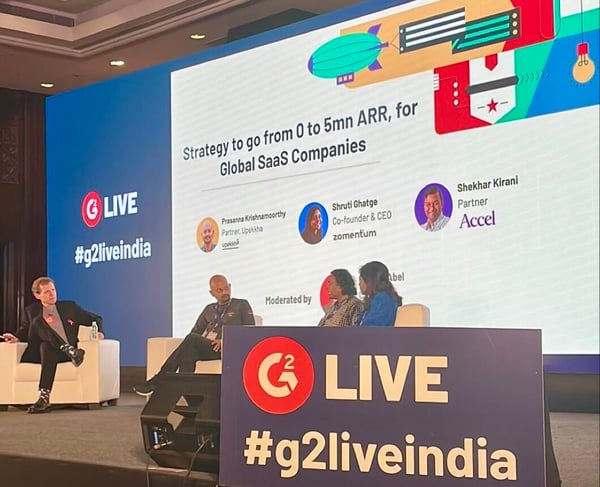In October, I had an incredible week visiting Bangalore, where we hosted two inaugural APAC events: G2 Kickoff and G2 Live.
Our first-ever G2 APAC Kickoff gathered 185+ G2ers from our Bangalore office. It was the first time many of our global leaders have been able to travel to India since the start of the pandemic, making this a truly special event.
I personally had a lot of fun being with our talented, motivated APAC team, which has been growing rapidly – 50% over the past year!
At our G2 Live India event, we invited members of the India SaaS community to discuss the journey of scaling SaaS globally, featuring 350+ participants, six speakers, and two thought-provoking panel discussions.

I loved feeling the energy of these events and enjoyed meeting so many brilliant Indian SaaS leaders and entrepreneurs. I’m still buzzing from the excitement and wanted to take a moment to pause and share some of my thoughts on the India SaaS ecosystem on the heels of my recent reflection on the European market.
Here are my main takeaways.
1. Indian SaaS is booming, outpacing other regions
I often talk about how software is booming globally in a 60-year mega trend. While this is certainly still the case, India is a bright spot. In fact, it represents the fastest-growing region, with a 48% year-over-year (YOY) growth rate in buyer traffic on G2.
Indian Saas has reached an inflection point, projected to hit $50B in annual recurring revenue (ARR) by 2023, according to data from Venture Intelligence. Investment continues to fuel this growth, with 20 new Indian unicorns so far in 2022, as reported by Tracxn, and $4.8B deployed in Indian SaaS in 2021 – which is 3x the amount in 2020 and 6x the amount seen in 2018, according to Bessemer Venture Partners.
A partner-driven approach to product development may be one driver of this growth. By leaning into partners with seamless integrations into customers’ existing tech stacks, Indian-founded companies can often provide a more affordable, faster/easier to implement, and specialized solution of an existing enterprise suite, leading to a rise in best-of-breed solutions in India that deliver maximized value for customers.
20
Indian unicorns emerged in 2022
Source: Tracxn
2. Software leaders are built globally, and increasingly in APAC
Supporting this growth, we also see the trend of more software leaders coming out of the APAC region. This is the case for G2 and many global companies we work with.
We know that software is a truly global product. As buyers continue to become region-agnostic, they’re looking for best-of-breed software built by entrepreneurs anywhere in the world.
I’m also convinced it’s making the world a better place. Once you account for translation and any local regulations, there is no reason why you shouldn’t find your next software tool from South Korea, Australia, or India.
3. Global software selling challenges are exacerbated in India, so adapting to buyer behavior trends is critical
We know that selling software is challenging as buyers’ needs, preferences, and purchasing journeys evolve rapidly. According to our 2022 G2 Software Buyer Behavior Report, global software buyers said their current top three buying considerations are ease of implementation, seeing ROI within six months, and ease of use.
They’re also turning to third-party marketplaces as they look to expedite and streamline the journey and turn to peer and expert sources they trust to guide their decisions. For software sellers, this challenges us to make things easier, build trust, break through the noise, and prove ROI faster than ever.
However, when we honed into the Indian market more deeply with our 2022 G2 India Software Buyer Behavior Report, we found that Indian buyers are more likely to be discerning, cost-sensitive, and focused on controlling spend, compared to global buyers. Ultimately, selling software is not easy, but these challenges are even more significant in this region.
To adapt to these buying trends and continue growing fast despite economic conditions, my advice to global SaaS companies – especially those catering to Indian buyers – is this:
- Delight users with easy setup and use
- Continuously collect customer feedback and reviews
- Leverage global marketplaces where buyers are increasingly shopping
- Drive smart growth via ABM fueled by buyer intent and content
We’ve seen more companies set up dedicated Customer Advocacy and Market Intelligence teams. Armed with the right approach and data, these teams can be very effective in influencing the buyer’s journey.
4. Indian SaaS persevered during COVID and will continue to accelerate in today’s uncertain economy
I learned a great deal while in Bangalore and feel more bullish than ever about SaaS momentum in APAC, specifically in India.
We saw the region’s exponential growth, even despite the COVID-19 pandemic, and expect the country will navigate today’s uncertain economic headwinds to continue accelerating its global SaaS leadership and innovation.
The growth is real and exciting, and I expect to see many global software vendors tapping into this market, with new innovators entering the fold.
Looking to the future
It’s an understatement to say that I’m looking forward to the continued growth of our G2 APAC team and beyond. The global opportunity for Indian SaaS vendors – in 2023 and beyond – is greater than ever.
And what better way to validate your customer centricity than with ROI? Build a trusted global brand and have your customers share authentic reviews on G2. Learn how to go global with G2.
 by Godard Abel
by Godard Abel
 by Godard Abel
by Godard Abel
 by Godard Abel
by Godard Abel